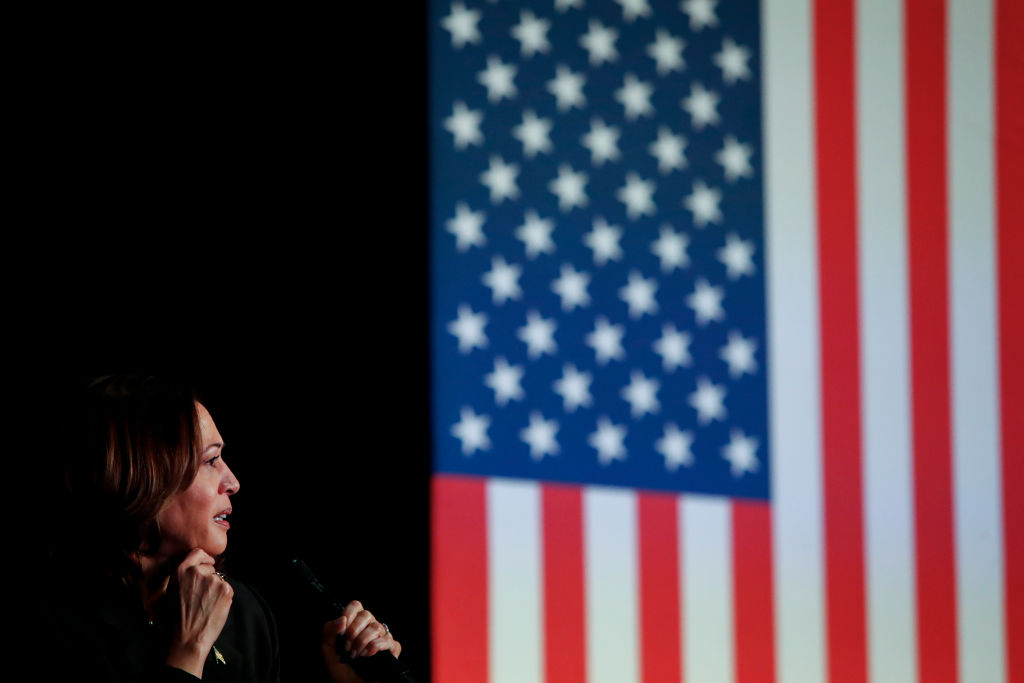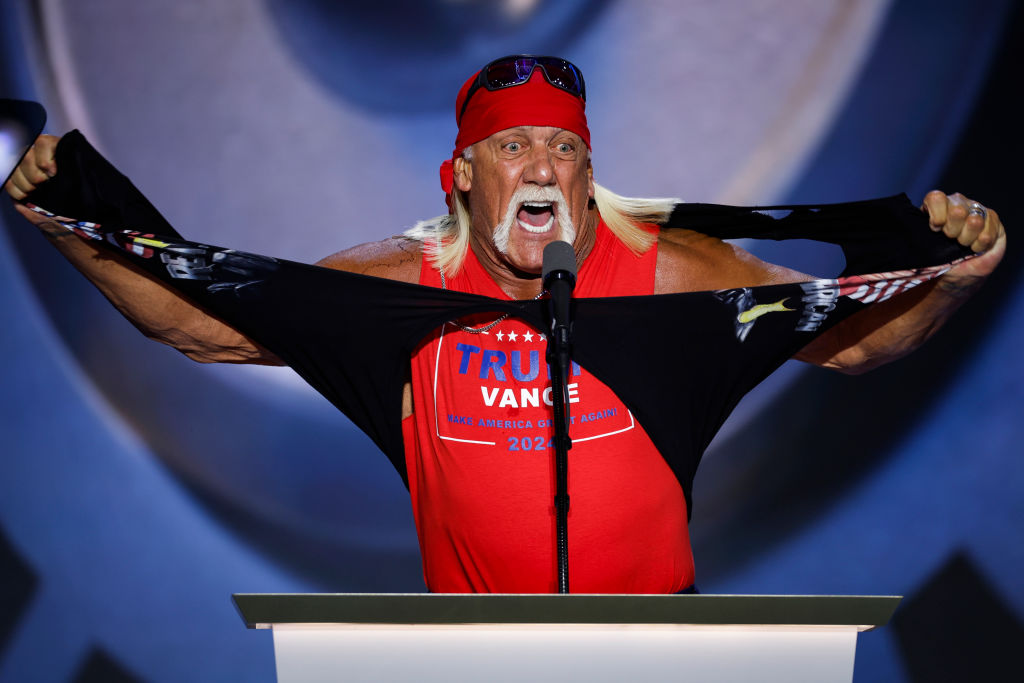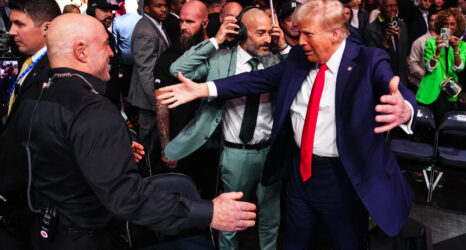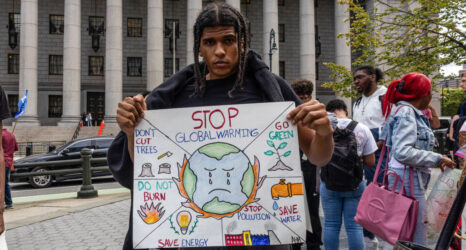The media can’t afford to ignore the right’s masculinity contests anymore.

Now that Joe Biden has announced his withdrawal from the 2024 presidential race and endorsed Vice President Kamala Harris, the salience of gender as a critical factor in the contest for the presidency will rise quickly to the surface. The surest way to make gender visible in presidential campaigns is to get a woman in the race.
But gender is always present in those campaigns—whether or not it’s visible. Even when two men run against each other, it’s not a “battle of the sexes” between a man and a woman: It’s a contest between two (usually white) men over competing versions of masculinity. That was the case up to the moment of Biden’s withdrawal. The 2024 campaign was gearing up to be a contest between two older white men who represent starkly divergent ideas about the very meaning of manhood.
Many commentators in mainstream and progressive media seem not to understand—or want to discuss—the deeply gendered nature of presidential campaigns or the presidency itself. This glaring deficit in political analysis was on full display in coverage last week of the Republican National Convention (RNC). The GOP put on a four-day, fist-pumping celebration of the manly virtues, culminating yet again in the anointing of a bombastic former real estate mogul, reality TV star and notorious misogynist as the supposed embodiment of those virtues.
The unapologetic celebration of a crude and embarrassingly cartoonish hypermasculinity was so extreme—especially on the penultimate day four—that some TV commentators had trouble mustering anything more thoughtful to say than what CNN’s Chris Wallace said on-air in response to a question from Jake Tapper: When Tapper asked Wallace, “What theme are we seeing at the convention tonight?” Wallace replied, “Testosterone.”
Maybe the political experts were caught off guard when World Wrestling Entertainment legend Hulk Hogan bellowed his enthusiasm for Donald Trump and the “real Americans” in the arena, and then—to the delight of the cheering throng—ripped off one shirt to reveal a Trump-Vance shirt underneath.
Or maybe they didn’t know how to respond when the take-charge, charismatic Ultimate Fighting Championship CEO Dana White gushed about Trump, in reference to the former president’s remarkably self-aware and instantly iconic response to the assassination attempt on July 13 in Butler, Pa.
“I’m in the tough guy business,” White said, “and this guy’s the toughest, most resilient guy I’ve ever met in my life.”
Even after a brief period of sober reflection, many seasoned political analysts were either unable or unwilling to talk about the masculinity politics of the convention or even to ask basic questions, such as: What did the ‘strong vs. weak’ theme that coursed through almost every convention speech and video suggest about how the GOP has decided to double down on its naked appeal to men—one of its chief electoral strategies over the past 45 years? Are polls that show the GOP making inroads with young Black and Latino men proof that their strategy of marketing themselves as the party of “real men” is working with these and other low-information, low-participation voters?

Alas, you wouldn’t find answers to any of these questions if you read or listened to political analysis in some of the nation’s most prominent news outlets and podcasts. While articles that discussed the masculinity politics of the RNC did appear in some media outlets, key sites of mainstream liberal commentary missed the boat. The estimable New York Times columnist Ezra Klein, on his popular podcast the day after the convention, never once even mentioned gender or masculinity as a theme at the RNC.
But if many TV pundits and political journalists weren’t ready to offer analytic depth, historical context or otherwise more thoughtful commentary about how presidential politics are deeply gendered, it’s either because they haven’t been paying close enough attention—or they haven’t done the reading.
Gender has long been at the center of American presidential politics. Since the 1980 election of Ronald Reagan over the incumbent Jimmy Carter, there has been a sizable gender gap in voting patterns in presidential elections. With important variations due to racial and class differences, women have generally supported the Democrats, and men the Republicans.
Gender was a huge factor in 2016, as it was the first time a woman topped a major party ticket. In that case, Hillary Clinton’s candidacy made gender visible, even as she lost the election to a man with a long, ugly and very public history of misogynous statements and behavior.
If Kamala Harris becomes the Democratic nominee selected to take on Donald Trump and the GOP, abortion rights are likely to become the biggest issue of the 2024 campaign, and questions about gender will move quickly to the front and center.
MAGA and the Remasculinization of America
When the RNC took place last week, Joe Biden had not yet announced he was withdrawing from the race. So when the GOP designed the theme of the convention, they aimed for it to highlight the contrast between Trump’s greatest political asset, the idea of him as an “alpha male” and political strongman, and Biden’s greatest weakness, the indelible image of him as physically weak and visibly frail.
This theme was entirely consistent with the party’s prime electoral task: the need to run the table with the men’s vote. GOP strategists know that because they almost always lose the women’s vote, and women vote in greater numbers than men, they can’t win national elections unless they rack up huge margins of victory among men—especially but not exclusively white men.
The way they’ve chosen to achieve this is not primarily by talking about policy. It’s by touting the manhood of the GOP candidate and mocking the masculinity of the Democrat. For anyone who hadn’t yet gotten the message, they distributed thousands of placards throughout the arena for delegates to wave that read, “Trump = Strength, Biden = Weakness.”
The broader theme of the slickly produced, made-for-TV event was that the revitalization of the American dream depends upon the remasculinization of American men through the divinely inspired leadership of the MAGA king himself, and his newly elevated prince, Ohio Senator JD Vance.
The hypermasculine posturing on display at the RNC was cartoonish and over-the-top. But for anyone who’s been paying close attention to presidential campaigns over the past few decades, it should not be surprising that a political convention designed to showcase and promote MAGA values would more closely resemble a Wrestlemania event than a traditional political gathering.
Since the introduction of television into presidential campaigns in 1960, and even more so in the contemporary era of digital communication and social media, presidential elections have been steadily moving away from an issues and policy focus toward one more fixated on questions of narrative, story and identity.
Over this same period, one of the tectonic shifts in this and other cultures has been the growing challenge to patriarchal power and privilege posed by the multiracial, multiethnic women’s movements, together with the challenge to heteronormative male centrality posed by the LGBTQ+ movements.
These movements for gender and sexual justice have been championed by the center-left as major steps forward in the Enlightenment project of expanding democratic freedoms, a long arc of history that dates back to the late 17th and 18th centuries. Meanwhile, the right has grown increasingly resentful of how these contemporary movements for social justice have undermined and destabilized men’s power and control, both within the family and in the larger society.
From white Christian nationalists to libertarian tech bros to post-liberal Catholics and the even fringier neo-monarchists, right-wing theorists and political strategists tend to see feminism and LGBTQ+ advancement not only as deeply worrying, but in some cases as an apocalyptic threat to the stability and viability of Western civilization itself.
Enter, stage right, the masterful multimedia performer Donald Trump. From the moment the garish former New York City tabloid fixture blustered his way into presidential politics in the 2016 election, his political persona was driven by the perception that he was a bold and brash businessman, a political “outsider” who had no patience for “political correctness” and no desire to apologize to anyone he’d offended—especially women.
His supporters freely admitted that what they loved most about him was that he “didn’t back down,” and that he “fought back.” In other words, they loved his performance of an aggrieved and unapologetic white manhood.
While many centrists, moderates, liberals and progressives were repulsed by how he seemed to constantly valorize and legitimate violent masculinity—evident in public statements he made over the years encouraging violent treatment of protesters at his rallies, endorsing police officers’ rough treatment of suspects and promising to use brutal force without mercy against America’s enemies—his supporters seemed to love him even more for it.
This brings us back to the RNC, the tightly scripted celebration of Trumpian virility it represented and the struggles of commentators to make sense of it all for their viewers, listeners and readers. The shallowness of analysis in media about the highly gendered nature of the RNC laid bare a major deficit in contemporary punditry. But it could also serve as a wake-up call.
It’s a call they’d better heed sooner rather than later because with Kamala Harris now as the presumptive Democratic nominee, the need for more thoughtful discussion on matters of gender and race will take on an unprecedented urgency. Political journalists are already writing about the challenge Harris will face attracting the votes of working-class white men in key states like Pennsylvania, Michigan and Wisconsin.
If the political pundit class wants to help Americans understand how cultural struggles over gender and race shape electoral narratives—and hence the choices available to voters this November and every election—it would behoove them to get up to speed on some of the brilliant feminist political journalism and political science research that’s been generated over the past several decades.
That’s where they’ll find invaluable insights not only about the daunting challenges women candidates for president still face but also about how the contemporary “crisis in masculinity” has set the stage for a growing right-wing movement to reclaim masculine authority.
It would also make sense for the punditocracy to get acquainted with the growing body of research and analysis of masculinities, race and politics that has proliferated since the 1990s. For anyone who wants insights about how and why American democracy has arrived at this perilous crossroads, and how historical disruptions in the gender order and deep-seated anxieties among millions of American men have rendered them vulnerable to the manipulations of a dangerous demagogue, it’s as good a place as any to start.
Up next:
U.S. democracy is at a dangerous inflection point—from the demise of abortion rights, to a lack of pay equity and parental leave, to skyrocketing maternal mortality, and attacks on trans health. Left unchecked, these crises will lead to wider gaps in political participation and representation. For 50 years, Ms. has been forging feminist journalism—reporting, rebelling and truth-telling from the front-lines, championing the Equal Rights Amendment, and centering the stories of those most impacted. With all that’s at stake for equality, we are redoubling our commitment for the next 50 years. In turn, we need your help, Support Ms. today with a donation—any amount that is meaningful to you. For as little as $5 each month, you’ll receive the print magazine along with our e-newsletters, action alerts, and invitations to Ms. Studios events and podcasts. We are grateful for your loyalty and ferocity.





